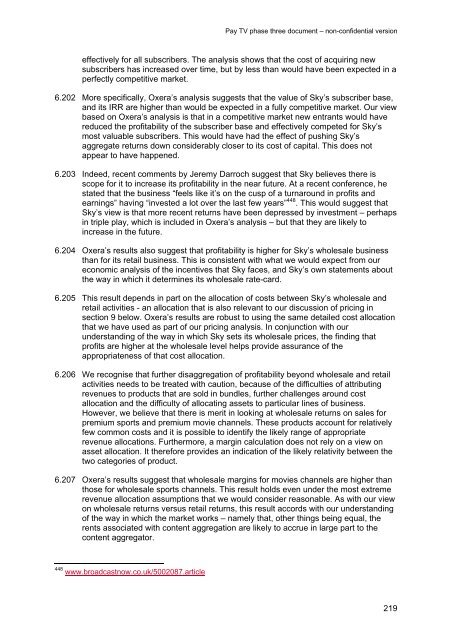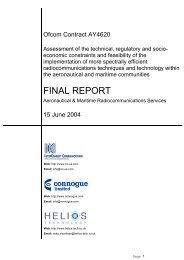Pay TV phase three document - Stakeholders - Ofcom
Pay TV phase three document - Stakeholders - Ofcom
Pay TV phase three document - Stakeholders - Ofcom
Create successful ePaper yourself
Turn your PDF publications into a flip-book with our unique Google optimized e-Paper software.
<strong>Pay</strong> <strong>TV</strong> <strong>phase</strong> <strong>three</strong> <strong>document</strong> – non-confidential version<br />
effectively for all subscribers. The analysis shows that the cost of acquiring new<br />
subscribers has increased over time, but by less than would have been expected in a<br />
perfectly competitive market.<br />
6.202 More specifically, Oxera’s analysis suggests that the value of Sky’s subscriber base,<br />
and its IRR are higher than would be expected in a fully competitive market. Our view<br />
based on Oxera’s analysis is that in a competitive market new entrants would have<br />
reduced the profitability of the subscriber base and effectively competed for Sky’s<br />
most valuable subscribers. This would have had the effect of pushing Sky’s<br />
aggregate returns down considerably closer to its cost of capital. This does not<br />
appear to have happened.<br />
6.203 Indeed, recent comments by Jeremy Darroch suggest that Sky believes there is<br />
scope for it to increase its profitability in the near future. At a recent conference, he<br />
stated that the business “feels like it’s on the cusp of a turnaround in profits and<br />
earnings” having “invested a lot over the last few years” 448 . This would suggest that<br />
Sky’s view is that more recent returns have been depressed by investment – perhaps<br />
in triple play, which is included in Oxera’s analysis – but that they are likely to<br />
increase in the future.<br />
6.204 Oxera’s results also suggest that profitability is higher for Sky’s wholesale business<br />
than for its retail business. This is consistent with what we would expect from our<br />
economic analysis of the incentives that Sky faces, and Sky’s own statements about<br />
the way in which it determines its wholesale rate-card.<br />
6.205 This result depends in part on the allocation of costs between Sky’s wholesale and<br />
retail activities - an allocation that is also relevant to our discussion of pricing in<br />
section 9 below. Oxera’s results are robust to using the same detailed cost allocation<br />
that we have used as part of our pricing analysis. In conjunction with our<br />
understanding of the way in which Sky sets its wholesale prices, the finding that<br />
profits are higher at the wholesale level helps provide assurance of the<br />
appropriateness of that cost allocation.<br />
6.206 We recognise that further disaggregation of profitability beyond wholesale and retail<br />
activities needs to be treated with caution, because of the difficulties of attributing<br />
revenues to products that are sold in bundles, further challenges around cost<br />
allocation and the difficulty of allocating assets to particular lines of business.<br />
However, we believe that there is merit in looking at wholesale returns on sales for<br />
premium sports and premium movie channels. These products account for relatively<br />
few common costs and it is possible to identify the likely range of appropriate<br />
revenue allocations. Furthermore, a margin calculation does not rely on a view on<br />
asset allocation. It therefore provides an indication of the likely relativity between the<br />
two categories of product.<br />
6.207 Oxera’s results suggest that wholesale margins for movies channels are higher than<br />
those for wholesale sports channels. This result holds even under the most extreme<br />
revenue allocation assumptions that we would consider reasonable. As with our view<br />
on wholesale returns versus retail returns, this result accords with our understanding<br />
of the way in which the market works – namely that, other things being equal, the<br />
rents associated with content aggregation are likely to accrue in large part to the<br />
content aggregator.<br />
448 www.broadcastnow.co.uk/5002087.article<br />
219
















